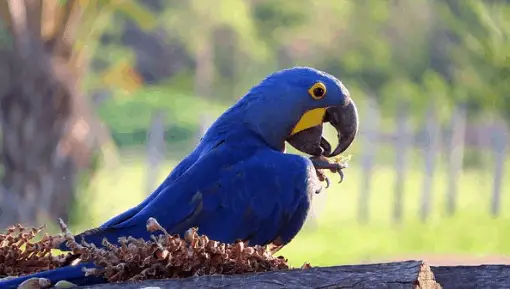Activity of text interpretation, aimed at students in the sixth year of elementary school, about the hyacinth macaw. It is the largest species among parrots (parrots, parakeets, macaws, parrots), measuring up to one meter from the tip of the beak to the tip of the tail and weighing up to 1.3 kg. Let's get to know the Hyacinth Macaw better? Did you know it is threatened with extinction? Find out more about this bird by reading the text “Blue Macaw: threatened beauty”. Then answer the various interpretative questions proposed!
This reading comprehension activity is available for download in an editable Word template, ready to print to PDF, as well as the completed activity.
Download this text interpretation exercise at:
SCHOOL: DATE:
PROF: CLASS:
NAME:
Read:
The hyacinth macaws (Anodorhynchus hyacinthinus) are animals that stand out for their beauty, size and behavior. It is the largest species among parrots (parrots, parakeets, macaws, parrots), measuring up to one meter from the tip of the beak to the tip of the tail and weighing up to 1.3 kg.
They are animals with habits that attract attention. They like to fly in pairs or in groups and in the late afternoons, gather in flocks in "dormitory" trees. Among its food sources are the nuts taken from the coconuts of two palm species: acuri and bocaiuva. In the case of acuri, they take advantage of those that have fallen on the ground, ruminated by cattle or wild animals. Coconut da bocaiuva is harvested and eaten directly from the bunch.
At age seven, the hyacinth macaw starts her own family. Couples are faithful and share the duties of caring for the puppies. The female spends most of her time in the nest, taking care of the incubation of eggs, while the male is responsible for feeding her. The incubation period lasts approximately 28 days.
Puppies are born fragile and are fed by their parents until they are six months old. They are at risk of life until they are 45 days old, as they cannot defend themselves against cockroaches, ants or other birds that invade the nest. Only three months old, when the body is covered with feathers, they venture on their first flights. On average, the female has two offspring, but usually only one survives.
In the Pantanal, 90% of hyacinth macaw nests are made on manduvi, a tree with a soft core. Ximbuva is also used (Enterolobium contortisiliquum) and the white angico (Albizia nipioides). Macaws increase small cavities in the trunk of trees to make their nests, which are lined with chips taken from the tree itself. There is dispute with other species because it is difficult to find natural cavities.
This beautiful bird, which delights everyone with its vibrant color and cheerful and noisy sound, has been suffering from the destruction of habitats and illegal capture for wildlife trafficking. The species is on the list of endangered species due to hunting, clandestine trade and the degradation of its habitat due to deforestation.
Available in:. (With cut).

Question 1 - The author of the text exposes a habit of the hyacinth macaws in the segment:
( ) “[…] they are animals that stand out for their beauty, size and behavior.”
( ) “It is the largest species among parrots (parrots, parakeets, macaws, parrots) […]”
( ) “They like to fly in pairs or in groups and in the evenings, they gather in flocks […]”
Question 2 - In the excerpt “[…] while the male is responsible for feeding her.”, the pronoun “la” was used to resume:
( ) “the hyacinth macaw”.
( ) “your own family”.
( ) “The female”.
Question 3 - According to the text, the pups of hyacinth macaws "are at risk of life until they complete 45 days", because:
( ) “[…] they are born fragile and are fed by their parents until they are six months old.”
( ) “[…] they cannot defend themselves against cockroaches, ants or other birds that invade the nest.”
( ) “[…] the female has two offspring, but in general, only one survives.”
Question 4 - According to the text, most hyacinth macaws in the Pantanal build their nests:
( ) in manduvi.
( ) in Ximbúva.
( ) in white angico.
Question 5 - Identify the life-threatening factors of hyacinth macaws:
A:
Question 6 – In the fragment “Macaws increase small cavities in the trunk of trees to make their nests […]”, the word “para” indicates:
( ) a destiny.
( ) a condition.
( ) a purpose.
Question 7 – In the excerpt “There is dispute with other species because it is difficult to find natural cavities.”, the highlighted part reads:
( ) the time of competition with other species.
( ) the reason for the dispute with other species.
( ) the consequence of the dispute with other species.
By Denyse Lage Fonseca
Graduated in Languages and specialist in distance education.
 report this ad
report this ad